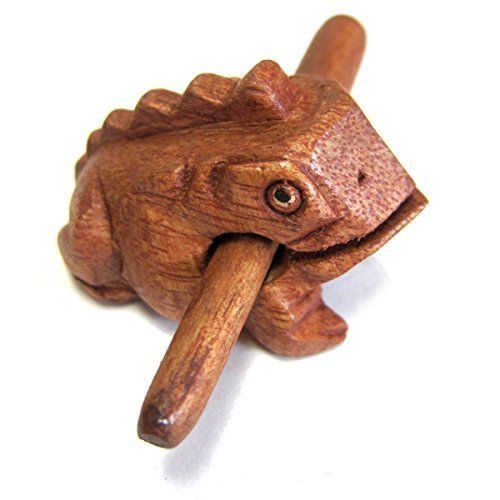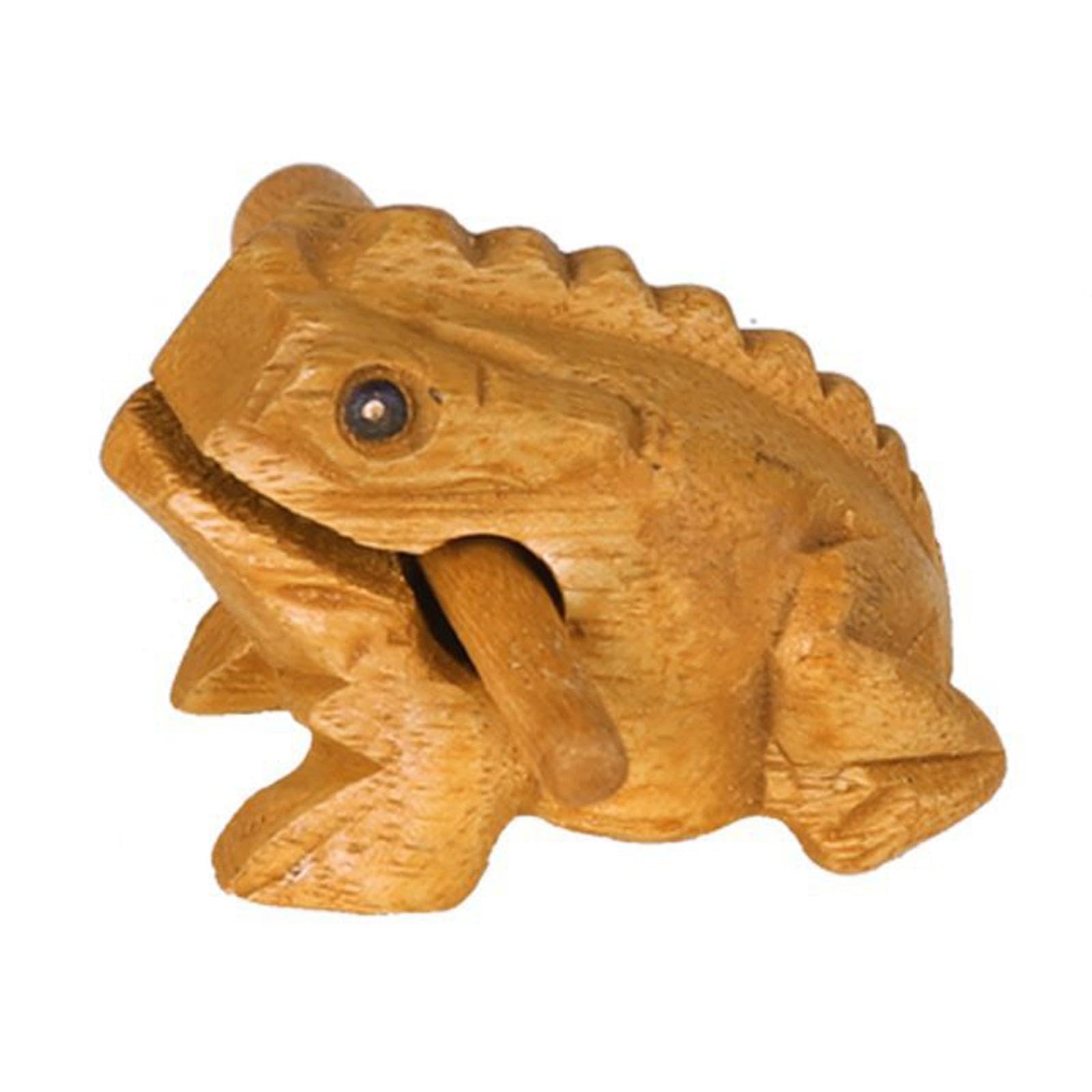Frog rasp
Percussions
Asia
Between 1901 and present
Video
The frog rasp is a percussion instrument that produces sound through friction. It is a type of scraped idiophone, meaning its sound is generated by scraping rather than striking or plucking. The instrument is typically crafted in the shape of a frog, often made from wood, and features a ridged surface along its back. A wooden stick, often referred to as a scraper, is used to rub against these ridges, creating a rasping sound. The size and shape of the frog rasp can vary, but the fundamental design remains consistent, focusing on the principle of friction-generated vibration.
This instrument is classified as a folk instrument, often used in traditional and ceremonial music. While the frog rasp is primarily made from wood, variations in materials, such as bamboo or synthetic materials, may sometimes be used for different tonal qualities. The instrument is commonly found in Southeast Asian cultures, particularly in Thailand and Vietnam, where it is used in cultural performances and rituals. Due to its simplicity, it is also a popular instrument for children and music educators, helping students understand the basics of rhythm and texture in music.
History and Origin
Origins and Cultural Use
The frog rasp is a percussion instrument that originates from traditional folk music in Southeast Asia and Latin America. It is commonly made from wood and carved into the shape of a frog, with ridges along its back. The instrument is played by running a wooden stick along these ridges, producing a rasping or croaking sound similar to a frog’s call.
- Thailand and Vietnam: Used in folk music and ceremonies, often as a novelty instrument mimicking nature.
- Mexico and Central America: Found in indigenous and folk music traditions.
- West Africa: Similar instruments exist, used in storytelling and rhythmic accompaniment.
While similar wooden rasp instruments exist in other cultures, the frog-shaped design became popular as a folk and novelty instrument in more recent times, particularly in Thailand, where it is commonly sold as a souvenir and used in traditional performances. Its design and playing technique resemble other friction-based instruments found in various indigenous cultures worldwide. However, the frog shape and its connection to regional folklore and symbolism make it unique to Asian countries.
Century of Emergence
Although it is difficult to pinpoint the exact century in which the frog rasp emerged, similar friction instruments have been in use for hundreds, if not thousands, of years. The use of rasping instruments can be traced back to ancient times when early humans discovered that scraping textured surfaces produced distinct sounds. As musical traditions developed, these instruments evolved into more specialized forms, including the frog rasp. Its use in Southeast Asian cultures suggests that it has existed for at least several centuries, playing a role in traditional ceremonies and folk music.
Types and Features
The frog rasp comes in several variations, primarily differing in size, material, and decorative features. These variations allow for different tonal qualities and uses in various musical and cultural settings. The most common types include:
Small Frog Rasp: These are compact and produce higher-pitched sounds. They are often used for light rhythmic accompaniment or as children’s instruments.
Medium Frog Rasp: These are the most commonly used size, producing a balanced sound suitable for both solo and ensemble performances.
Large Frog Rasp: These produce deeper, more resonant tones and are often used in ceremonial or theatrical performances where a fuller sound is required.
Decorative Frog Rasps: Some versions are highly ornate, featuring intricate carvings and painted designs. These are often sold as souvenirs or used in cultural exhibitions.
Despite these differences, all frog rasps function similarly, relying on the friction between the ridged surface and the wooden scraper to generate sound. The size and depth of the ridges influence the pitch and texture of the sound produced.
Work Mechanics
The mechanics of the frog rasp are simple yet effective in producing rhythmic and percussive sounds. The primary elements of its operation include the ridged back, the scraper, and the way in which friction is applied.
To produce sound, the player holds the frog rasp firmly in one hand and uses the other hand to scrape the wooden stick along its ridges. This motion creates a rasping sound that varies in tone and intensity depending on the speed and pressure applied. The technique can be adjusted to produce different rhythmic patterns, making the instrument versatile in various musical settings.
Some musicians also use the frog rasp as a sound effect tool rather than a primary musical instrument. By varying the angle and force of the scraping motion, they can produce a range of sounds, from soft, delicate chirps to more pronounced, aggressive rasps. In some traditional performances, players may incorporate additional techniques, such as striking the body of the frog rasp to create a percussive accent.
Role in Music
The frog rasp is primarily used as a rhythm instrument in folk and traditional music. It serves as a percussive element that enhances the texture of a musical piece. While it is not typically used as a solo instrument, it plays an essential role in ensemble settings, adding an organic and naturalistic sound that complements other instruments.
In Southeast Asian music, the frog rasp is often used in storytelling performances, ceremonial music, and cultural festivities. Its rasping sound is sometimes associated with natural themes, such as the sounds of the rainforest or the croaking of actual frogs, making it a fitting instrument for performances depicting nature or folk tales.
Outside of traditional contexts, the frog rasp has found a place in modern music as well. Some experimental musicians and composers incorporate it into contemporary compositions, using its unique texture to create atmospheric soundscapes. Additionally, music educators frequently use the instrument in classrooms to teach students about rhythm, sound production, and cultural musical traditions.
Significance of the Frog Rasp
The frog rasp holds cultural, educational, and artistic significance. It is more than just a simple percussion instrument; it carries symbolic and traditional value in the regions where it is commonly used.
One of its most notable cultural significances is its connection to folklore and symbolism. In many Southeast Asian cultures, frogs are associated with prosperity, rain, and fertility. The frog rasp, therefore, is often linked to rituals and performances that celebrate these themes. In some cases, it is used in ceremonies meant to invoke rainfall, reflecting its deep-rooted connection to nature. From an educational perspective, the frog rasp is an excellent tool for introducing children and beginners to musical concepts. Its simple playing technique makes it accessible to individuals of all ages and skill levels. Teachers use it to demonstrate the principles of rhythm, sound production, and texture, making it a valuable instrument in early music education.
Artistically, the frog rasp is appreciated not only for its sound but also for its craftsmanship. Many frog rasps are beautifully carved and decorated, making them collectible items as well as functional musical instruments. The artistry involved in crafting these instruments reflects the cultural heritage of the regions where they are made, preserving traditional woodworking and instrument-making techniques.
FAQ
What type of music is the frog rasp typically used in?
The frog rasp is typically used in African folk music, Latin American music (such as salsa and Afro-Cuban music), and classical music compositions.
What materials are commonly used to make a frog rasp?
Frog rasps are commonly made from wood, such as cedar or mahogany. They can also be made from other materials like gourds or fiberglass.
How is the sound produced on a frog rasp?
Sound is produced on a frog rasp by scraping the ridges with a stick or mallet. Other techniques include tapping and sliding the stick along the ridges.
 Links
Links
References
Other Instrument
Categories



















